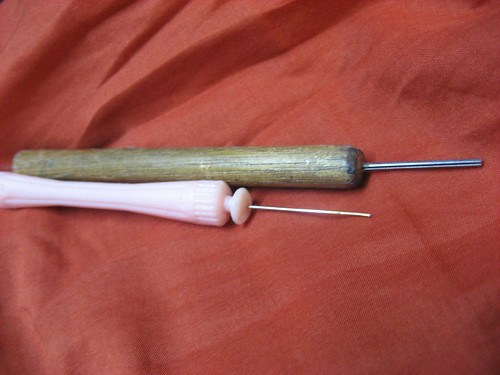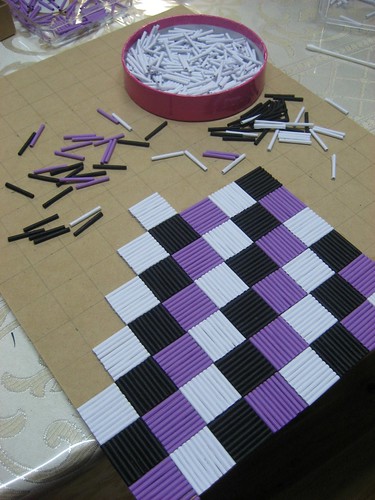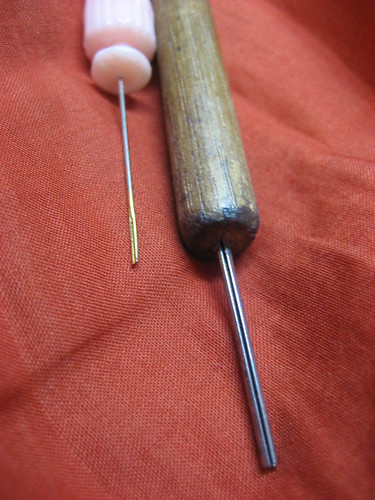Quilling Tools
When I featured Licia Politis's incredible Quilled Day at the Races recently, I promised she would introduce us to the quilling tools that help her create such magic. Take it away, Licia!
The wooden handled tool is the very first one I used when learning to quill. It has a small slot that doesn't go all the way through the metal shaft - this is a different feature than most slotted tools. The advantage is that it makes it possible to produce a coil with a clean, smooth center (i.e. no crimp), as long as you roll the tool a few extra revolutions after the coil end is glued.
I used the wooden tool to make the checkerboard cylinders because it's great when you want to roll very, very fast. I can roll about a hundred per hour at my fastest rate...that's with the paper pre-cut and no interruptions. [Ann interrupts to say, Who says quilling is slow?!]

The type of slotted tool that Licia uses (slot doesn't go completely through the shaft) is a tool usually used for rolling paper beads. Available via Etsy here (U.S.)and here (UK).
Thanks Licia, for sharing your tool tips with us!
The wooden handled tool is the very first one I used when learning to quill. It has a small slot that doesn't go all the way through the metal shaft - this is a different feature than most slotted tools. The advantage is that it makes it possible to produce a coil with a clean, smooth center (i.e. no crimp), as long as you roll the tool a few extra revolutions after the coil end is glued.
I used the wooden tool to make the checkerboard cylinders because it's great when you want to roll very, very fast. I can roll about a hundred per hour at my fastest rate...that's with the paper pre-cut and no interruptions. [Ann interrupts to say, Who says quilling is slow?!]
The other tool with the pink handle was homemade using a hair perm rod and tapestry needle, size 26. A hot air gun (embossing tool) was used to heat the pointed end of the needle, which was then carefully inserted into the plastic using pliers. The very tip of the eye of the needle was cut off, also with pliers, to create a slot where a strip is inserted. If the needle prongs are a little sharp, I file them on cement or bricks.
Using this needle tool you certainly can get the crimped result if you allow it. With a bit of extra rolling though, the coil will release from the tool. The pressure of the needle against the paper smooths the crimped end, making the center circular. When I start the strip in the needle, the paper is only just in the slot, not through the other side. This is important, as otherwise you won't be able to get the needle to release the paper when rolling those extra revolutions. It will also cause the fine needle to break, as the constant extra turns put a lot of pressure on it. I always miss an old, "broken-in" tool when a prong snaps!
I use the perm rod needle tool more than the metal tool, but the metal one has been very useful over the years. Instead of a perm rod, the tapestry needle can be inserted into a wooden dowel, but the soft rod is more comfortable to grip. The needle attaches so much better to the hot plastic too, and stays in place, unlike the way it can loosen inside a dowel, rendering it useless.
I use the perm rod needle tool more than the metal tool, but the metal one has been very useful over the years. Instead of a perm rod, the tapestry needle can be inserted into a wooden dowel, but the soft rod is more comfortable to grip. The needle attaches so much better to the hot plastic too, and stays in place, unlike the way it can loosen inside a dowel, rendering it useless.

The type of slotted tool that Licia uses (slot doesn't go completely through the shaft) is a tool usually used for rolling paper beads. Available via Etsy here (U.S.)and here (UK).
Thanks Licia, for sharing your tool tips with us!
All Things Paper is an Etsy affiliate.





